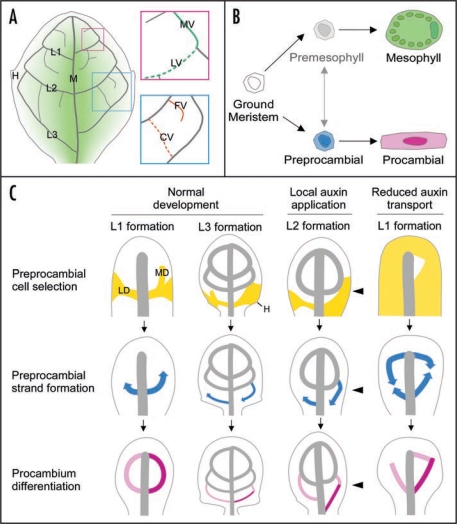Figure 1.
Conceptual summary of dicot leaf vein formation. (A) Schematics of a simplified mature leaf illustrating midvein (M), first, second and third loops (L1, L2 and L3, respectively)—each derived from corresponding lateral (LV) and marginal (MV) veins—free-ending (FV) and connected (CV) higher-order veins, hydathodes (H) and middle-to-margin positions (decreasing green gradient) as used in the text. (B) State transitions in leaf subepidermal cell differentiation. Available evidence suggests that the vein patterning process is limited to ground meristem cells (white), while subepidermal cells that have begun to acquire mesophyll characteristics are incapable of responding to vein-inducing signals.11,13,19,38 Expression of preprocambial (blue) and mesophyll emergence markers seem to identify two mutually exclusive and typically irreversible cell states, one leading to procambium (pink) and the other to mature mesophyll (green) formation. The transition from ground meristem to differentiated mesophyll could conceivably occur through a cell state that is formally equivalent to the preprocambial state in vascular differentiation. However, the existence of such a ‘premesophyll’ state (faded gray), the extent of its stability, its mutual exclusivity or competition with the preprocambial state and its responsiveness to vein-inducing signals still remain open questions. (C) Stage-specific dynamics of leaf vein patterning and their dependency on auxin levels and transport as exemplified for loop formation, but in general equally applicable to all veins. Upper series: PIN1-labeled auxin transport paths corresponding to preprocambial cell selection zones (yellow). Note how loops are composed of a lateral PIN1 expression domain (LD) and an initially free-ending marginal PIN1 expression domain (MD). Further, note slightly expanded PIN1 expression domains in a fraction of hydathode-associated third loops during normal development, broad PIN1 domains on the side of local auxin application (arrowhead) and nearly ubiquitous PIN1 expression upon systemic auxin transport inhibition. Middle series: directions of Athb8/J1721-marked preprocambial strand formation (blue arrows). Note middle-to-margin progression of preprocambial strand formation during normal loop development. Further, note margin-to-middle preprocambial strand extension in a fraction of third loops during normal development and in all loops forming on the side of auxin application. Finally, note co-existence of middle-to-margin and margin-to-middle polarities of preprocambial strand extension during the formation of individual loops in response to auxin transport inhibition. Lower series: gradual appearance of procambial cell identity acquisition (pink to magenta). Note simultaneous differentiation of lateral and marginal procambial strands in normal loop development. Further, note successive formation of lateral and marginal procambial strands in a fraction of third loops during normal development and in all loops formed on the side of auxin application and under conditions of reduced auxin transport. Arrows temporally connect successive stages of vein formation. See text for additional details.

